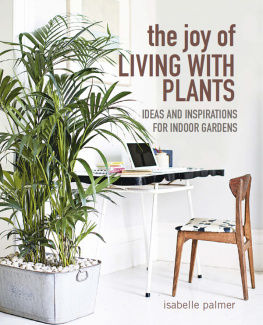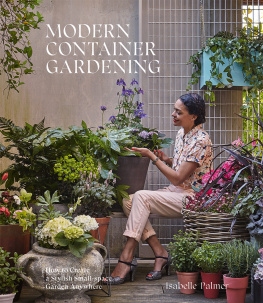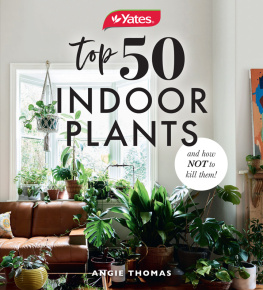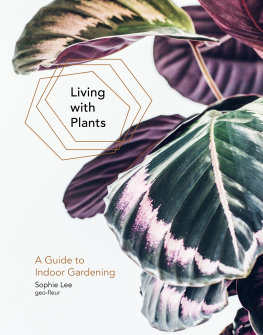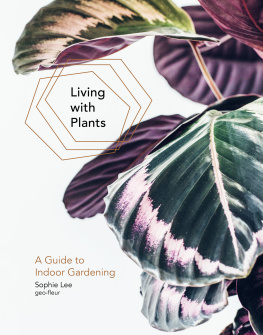Isabelle Palmer - The Joy of Living with Plants
Here you can read online Isabelle Palmer - The Joy of Living with Plants full text of the book (entire story) in english for free. Download pdf and epub, get meaning, cover and reviews about this ebook. year: 2021, publisher: Ryland Peters & Small, genre: Children. Description of the work, (preface) as well as reviews are available. Best literature library LitArk.com created for fans of good reading and offers a wide selection of genres:
Romance novel
Science fiction
Adventure
Detective
Science
History
Home and family
Prose
Art
Politics
Computer
Non-fiction
Religion
Business
Children
Humor
Choose a favorite category and find really read worthwhile books. Enjoy immersion in the world of imagination, feel the emotions of the characters or learn something new for yourself, make an fascinating discovery.
- Book:The Joy of Living with Plants
- Author:
- Publisher:Ryland Peters & Small
- Genre:
- Year:2021
- Rating:4 / 5
- Favourites:Add to favourites
- Your mark:
- 80
- 1
- 2
- 3
- 4
- 5
The Joy of Living with Plants: summary, description and annotation
We offer to read an annotation, description, summary or preface (depends on what the author of the book "The Joy of Living with Plants" wrote himself). If you haven't found the necessary information about the book — write in the comments, we will try to find it.
The Joy of Living with Plants — read online for free the complete book (whole text) full work
Below is the text of the book, divided by pages. System saving the place of the last page read, allows you to conveniently read the book "The Joy of Living with Plants" online for free, without having to search again every time where you left off. Put a bookmark, and you can go to the page where you finished reading at any time.
Font size:
Interval:
Bookmark:

the joy of
LIVING WITH PLANTS


the joy of
LIVING WITH PLANTS
IDEAS AND INSPIRATIONS FOR INDOOR GARDENS
isabelle palmer

To my Grandmother, my guiding light
This edition published in 2021 by CICO Books
an imprint of Ryland Peters & Small
2021 Jockeys Fields, London WC1R 4BW
341 E 116th St, New York, NY, 10029
First published in 2016 as House Plants
www.rylandpeters.com
10 9 8 7 6 5 4 3 2 1
Text Isabelle Palmer 2016
Design and photography CICO Books 2016
The authors moral rights have been asserted. All rights reserved. No part of this publication may be reproduced, stored in a retrieval system, or transmitted in any form or by any means, electronic, mechanical, photocopying, or otherwise, without the prior permission of the publisher.
A CIP catalog record for this book is available from the Library of Congress and the British Library.
ISBN: 978 1 80065 027 5
E-ISBN: 978 1 80065 064 0
Printed in China
Copy editor: Caroline West
Designer: Mark Latter
Photographer: Helen Cathcart
Stylist: Marisa Daly
Art director: Sally Powell
Production manager: Gordana Simakovic
Publishing manager: Penny Craig
Publisher: Cindy Richards

CONTENTS

introduction
Living in the city, I am very aware that outdoor space is at a premium. During the winter, while looking out at my balconies and dreaming of the summer, I started thinking: what if you wanted to have that little bit of green, but didnt have any outside space at all? This turned my attention indoors. The house plant, once an integral part of homes everywhere, had gone out of fashion. However, Ive noticed a renewed interest in house gardening. Even if you live in the country, indoor plants can offer some much-needed contact with nature, something that is very important, not only in terms of aesthetics, but also to promote a healthy emotional environment. House plants bring their natural form, color, and fragrance to the home, and can add the finishing touch to many interior schemes.
Historically, plants have been used indoors for centuriesindeed, medieval paintings depict Crusaders returning with plant specimens from many corners of the world. The Victorian period in the nineteenth century was a golden age of plant collecting, which went hand in hand with the Victorians passion for exploration and discovery. The Victorian plant hunters were seen as adventurers traveling to remote areas to bring back exotic plants from around the world. This era also saw a rise in popularity of terrariums and Wardian cases. The legacy of these Victorian plant explorers lives on in the plants that thrive in our modern natural landscape.
In this book, I will show you how to choose, grow, and decorate with house plants, as well as guide you through the different techniques needed to care for your new green guests.
there is nothing more pleasing than bringing greenery into your home. Not only are plants beautiful but many can clean household air and balance humidity


tools & techniques
This may be your first foray into nurturing house plants, or you may be a seasoned pro. Even so, most people need to look afresh at their house plant displays now and then, so, although you may be using this book only as a source of inspirational ideas, I will cover the basics of growing house plants from start to finish, as this is a book for both the beginner and the experienced gardener. The main requirements for growing healthy house plants are a well-lit, draft-free spot with an even temperature and reasonably high humidity. However, some plants have specific needs, and this section will show you how to care for them.

TOOLS AND MATERIALS
The tools and materials you use are really important when caring for and maintaining your house plants. You dont need to spend a fortune, however, as many tools can be made from household spoons, forks, and knives with a bit of tape and a long stick. Here, I have outlined the most useful tools for all the projects in this book.

A selection of tools: scissors, magnifying glass, mini rake, glass cleaner, small brush, long-handled tweezers, bamboo stick, floristry pins and wire, long-handled scissors, mini spade, mini trowel.
useful tools
Mini spades or trowels for digging holes and moving objects in containers.
Mini rake for raking over and patting down the potting mix.
Sticks are great for moving and positioning plants in difficult areas and also for making holes in the potting mix when you are sowing seeds.
Stiff paper for making a funnel to pour materials into small, difficult-to-access containers.
Long-handled tweezers are useful for grabbing plants when youre positioning them in small containers.
A magnifying glass is helpful for enlarging small objects when planting up a terrarium.
Scissors are one of the most useful tools, as you will find them really helpful for deadheading, trimming back, tidying up, pruning, and taking cuttings.
Long-handled scissors are great for pruning and tweaking off dead leaves.
Leaf pruners are really useful for cutting more woody and mature plant stems that cannot be cut with a pair of scissors.
Root clippers are a great tool when youre repotting plants (especially bonsai) and also for propagating plants by division.
Homemade glass cleaner for cleaning difficult-to-reach areas inside pots, glass vases, and terrariums. To make your own, simply stick a small sponge onto the end of a chopstick.
Small brushes are useful for brushing stray potting mix from leaves.
Bamboo sticks and trellis are ideal for providing plants such as climbers with a form of support, and for training plants.
Wire for training plants, such as Passiflora (passionflower) and Hedera (ivy), as well as for tying in untidy branches. A good green-coated floristry wire is perfect, as the green will blend in with the plant.
Floristry pins are great for holding down mosses and fixing parts of clump moss together.
A ball of string is useful for securing climbing plants and fixing moss around plants, such as in the hanging fruit garden project (see ).
Font size:
Interval:
Bookmark:
Similar books «The Joy of Living with Plants»
Look at similar books to The Joy of Living with Plants. We have selected literature similar in name and meaning in the hope of providing readers with more options to find new, interesting, not yet read works.
Discussion, reviews of the book The Joy of Living with Plants and just readers' own opinions. Leave your comments, write what you think about the work, its meaning or the main characters. Specify what exactly you liked and what you didn't like, and why you think so.

